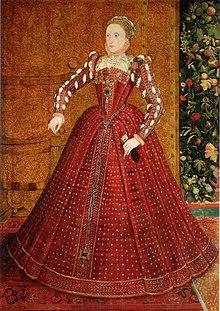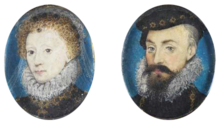| A young Elizabeth |
Elizabeth was born in 1533, the daughter of King Henry VIII and his second wife, Anne Boleyn. Anne was a protestant, and had influenced Henry to break from the Catholic Church so that he could divorce his first wife, Catherine of Aragon, and marry her.
| Anne Boleyn and Henry VIII |
| Queen Mary |
Mary, a devout Catholic, sought to reunite England with the Catholic Church. During her five year reign she earned the title 'Bloody Mary', as she restored medieval heresy laws, and burned over 280 protestants. Protestant Thomas Wyatt attempted to raise a rebellion against Mary in 1554, with the goal of placing Elizabeth (raised a protestant, like her mother) on the throne.The rebellion was suppressed, and though Elizabeth claimed she was not personally involved, she was imprisoned for a year. Though Mary could have had her executed for treason, she chose to spare her sister's life. As Mary left no heir, Elizabeth became queen when she died in 1558.
 |
| Coronation portrait of Elizabeth I |
Elizabeth was 25 when her reign began. England was at war with France, which had drained the economy, and the religious reformation was creating conflict internally. Almost immediately, Elizabeth sought to repair the rift between the Catholics and Protestants of her country. Though she was a Christian woman, she had no desire to 'dispute over trifles', and would not tolerate fundamentalism. The heresy laws that applied under Mary's reign were abolished, and though there were laws created pertaining to the compulsory use of the Book of Common Prayer and attendance at Church, the punishment for failing to do so was not severe. The burning of heretics at the stake became a thing of the past.
| Mary, Queen of Scots being led to the scaffold |
Regardless of her moderate rule, there was still Catholic opposition, with many Catholics believing that Elizabeth's cousin, Mary, Queen of Scots had a greater claim to the throne. Rebellions and assassination attempts were raised in her name, and whilst none were successful, Mary spent the greater part of 20 years imprisoned. Though Mary's very presence was a threat to her own life, Elizabeth appeared reluctant to follow through with a death sentence for her cousin. Eventually, however, having been shown irrefutable evidence of Mary's involvement in plots to overthrow her, Elizabeth caved and sanctioned Mary's trial and execution (though she said later that it was not done on her orders).
 |
| The Hampden portrait, made shortly before the 'Virgin Queen' iconography began |
 |
| Miniatures of Elizabeth and Robert Dudley |
 |
| The Rainbow Portrait, c.1600 |
Elizabeth was fiercely independent and desired to remain sole ruler of her realm. She cultivated her image as the 'Virgin Queen', and she was idolised by many. Being a single female and holding so much power meant that she was idolised as a goddess, something more than human. What added to this image was her heavy use of cosmetics and wigs following her illness with smallpox, which left her badly scarred. She created herself as she wished to be seen. The make-up concoction that made her look so pale was made of white lead and vinegar, which must have impacted her health, but even as she aged, portraits of her became more and more idealistic, as evidenced by the 'Rainbow Portrait' (displayed to the right), which was painted when she was 67 years old. She appears ageless.
| The defeat of the Spanish Armada |
 |
| Elizabeth at age 62 |
In the later years of Elizabeth's reign there was a marked decline in her popularity, due to the strain on the economy that war had inflicted, failed crops food shortages and dramatic changes to her privy council. Many of the members of her original privy council had passed away by the 1590s and it was then made up of ambitious men, who struggled between themselves for the most powerful positions. Elizabeth's personal power in matters of state grew less and less.
As Elizabeth's power declined, the culture of her country flourished. With the consistency and stability of Elizabeth's reign, and the people no longer under pressure to subscribe to one belief or another, the doors were opened for a creative revolution. The period is known for its advances in fashion (Elizabeth herself was a fashion icon), literature, theatre, painting and music.
Upon Elizabeth's death, James VI of Scotland (the son of Elizabeth's past rival Mary, Queen of Scots) inherited her throne, becoming James I of England. Though he was also a protestant, he was accused of being a Catholic sympathiser and was generally unpopular, which prompted a cultural show of nostalgaia for Elizabeth. She was remembered as the heroine of her people, virtuous and strong. A leader who had brought England from turmoil into a golden age of prosperity. Her memory has been revived many times since, when England faces adversity. She has become an enduring symbol of progress, and Great Britain's pride and strength.
Sources:
http://www.biography.com/people/queen-elizabeth-i-9286133#related-video-gallery
http://www.bl.uk/learning/histcitizen/uk/armada/back/backd.html
https://en.wikipedia.org/wiki/Elizabeth_I_of_England

No comments:
Post a Comment